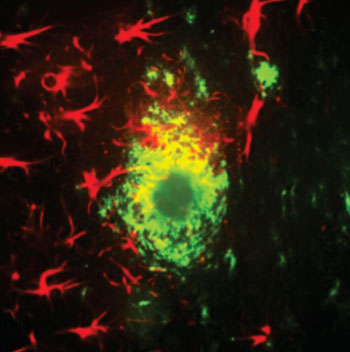Experimental Cancer Drug Reverses Symptoms in Mouse Model of Alzheimer's Disease
By LabMedica International staff writers
Posted on 14 Apr 2015
An experimental, but clinically disappointing drug for treatment of cancer has been found to be extremely effective in reversing the symptoms of Alzheimer's disease (AD) in a mouse model.Posted on 14 Apr 2015
The drug, AZD05030 (Saracatinib), developed by Astra Zeneca (London, United Kingdom) is a potent Src inhibitor to c-Yes, Fyn, Lyn, Blk, Fgr and Lck; less active for Abl and EGFR. As investigators at Yale University (New Haven, CT, USA) were aware that the Fyn tyrosine kinase was implicated in AD pathology where it was triggered by amyloid-beta oligomers (A-beta o) and propagated by Tau; the theorized that Fyn inhibition would prevent or delay disease progression.

Image: Star-like glial cells in red surround alpha-beta plaques in the cortex of a mouse with a model of Alzheimer\'s disease (Photo courtesy of Strittmatter laboratory/Yale University).
To this end they sought to repurpose the Src family kinase inhibitor cancer drug, AZD0530, for AD. Initially they evaluated the pharmacokinetics and distribution of AZD0530 in mice. Inhibition of A-beta o signaling to Fyn, Pyk2, and Glu receptors by AZD0530 was tested by brain slice assays. After AZD0530 or vehicle treatment of wild-type and AD transgenic mice, memory was assessed by Morris water maze and novel object recognition. For these cohorts, amyloid precursor protein (APP) metabolism, synaptic markers (SV2 and PSD-95), and targets of Fyn (Pyk2 and Tau) were studied by immunohistochemistry and by immunoblotting.
Results published in the March 21, 2015, online edition of the journal Annals of Neurology revealed that AZD0530 potently inhibited Fyn and prevented both A-beta o-induced Fyn signaling and downstream phosphorylation of the AD risk gene product Pyk2 in brain slices. After four weeks of treatment, AZD0530 dosing of APP/PS1 transgenic mice fully rescued spatial memory deficits and synaptic depletion, without altering APP or A-beta metabolism. AZD0530 treatment also reduced microglial activation in APP/PS1 mice, and rescued Tau phosphorylation and deposition abnormalities in APP/PS1/Tau transgenic mice. There was no evidence of AZD0530 chronic toxicity.
"With this treatment, cells under bombardment by beta amyloid plaques show restored synaptic connections and reduced inflammation, and the animal's memory, which was lost during the course of the disease, comes back," said senior author Dr. Stephen M. Strittmatter, professor of neurology at Yale University.
Related Links:
Yale University













